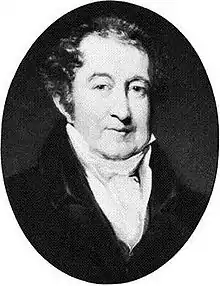George Colman the Younger
George Colman (21 October 1762 – 17 October 1836), known as "the Younger", was an English dramatist and miscellaneous writer. He was the son of George Colman the Elder.
George Colman | |
|---|---|
 | |
| Born | 21 October 1762 |
| Died | 17 October 1836 (aged 73) |
| Nationality | British |
| Education | Westminster School; Christ Church, Oxford; King's College, Aberdeen |
| Occupation | Playwright; examiner of plays |
Life
He passed from Westminster School to Christ Church, Oxford, and King's College, University of Aberdeen, and was finally entered as a student of law at Lincoln's Inn, London. While in Aberdeen he published a poem satirizing Charles James Fox, called The Man of the People; and in 1782 he produced, at his father's playhouse in the Haymarket, his first play, The Female Dramatist.

The failing health of the elder Colman obliged him to relinquish the management of the Haymarket theatre in 1789, when the younger George succeeded him, at a yearly salary of £600. On the death of the father the patent was continued to the son; but difficulties arose in his way, he was involved in litigation with Thomas Harris, and was unable to pay the expenses of the performances at the Haymarket. He was forced to take sanctuary within the Rules of the King's Bench Prison. Here he resided for many years continuing to direct the affairs of his theatre.
Released at last through the kindness of George IV, who had appointed him exon. of the Yeomen of the Guard, a dignity disposed of by Colman to the highest bidder. In 1824 he was made examiner of plays by the duke of Montrose, then Lord Chamberlain. This office, to the disgust of all contemporary dramatists, to whose manuscripts he was as illiberal as he was severe, he held till his death. Although his own productions were open to charges of indecency and profanity, he was so severe a censor of others that he would not pass even such words as "heaven", "providence" or "angel".
He had, as early as 1784, contracted a runaway marriage with an actress, Clara Morris, to whose brother David Morris, he eventually disposed of his share in the Haymarket theatre. Many of the leading parts in his plays were written especially for Mrs Gibbs (née Logan), whom he married at Clerkenwell in June 1836, after the death of his first wife in January that year.[1]
He died in Brompton, London. He was buried alongside his father in Kensington Church.[2]
Works

His comedies are a curious mixture of genuine comic force and sentimentality. A collection of them was published (1827) in Paris, with a life of the author, by J. W. Lake.
His first play, The Female Dramatist (1782), for which Smollett's Roderick Random supplied the materials, was unanimously condemned, but Two to One (1784) was entirely successful. It was followed by Turk and no Turk (1785), a musical comedy; Inkle and Yarico (1787), an opera; Ways and Means (1788); The Battle of Hexham (1793); The Iron Chest (1796), taken from William Godwin's Adventures of Caleb Williams; The Heir at Law (1797), which enriched the stage with one immortal character, "Dr Pangloss" (borrowed of course from Voltaire's Candide); The Poor Gentleman (1802); John Bull, or an Englishman's Fireside (1803),[3] his most successful piece; and numerous other pieces, many of them adapted from the French.
Colman, whose witty conversation made him a favourite, was also the author of a great deal of so-called humorous poetry (mostly coarse, though much of it was popular) – My Night Gown and Slippers (1797), reprinted under the name of Broad Grins, in 1802; and Poetical Vagaries (1812). Some of his writings were published under the assumed name of Arthur Griffinhood of Turnham Green.
Literary hoaxes
After his death, Colman was falsely stated to have been the author of certain pornographic works. The Rodiad, on flagellation, was published by John Camden Hotten in 1871, falsely dated to 1810 and ascribed to Colman;[4] the true author seems to have been Richard Monckton Milnes, 1st Baron Houghton.[5][6][7] Canadian author John Glassco maintained and extended the hoax in 1967 by repeating the attribution and also claiming that his own Squire Hardman had been written by Colman.[8]
Further reading
See the second George Colman's memoirs of his early life, entitled Random Records (1830), and RB Peake, Memoirs of the Colman Family (1842).
References
- Terry Jenkins, 'The true facts of Colonel John George Nathaniel Gibbes' in Traces; uncovering Australia's past, No. 13 (Melbourne, December 2020).
- Dictionary of National Biography
- archive.org
- Knight, George Wilson (1971). Neglected powers: essays on nineteenth and twentieth century literature. Routledge. p. 129. ISBN 0-7100-6681-3.
- Whyte, Christopher (1995). Gendering the nation: studies in modern Scottish literature. Edinburgh University Press. p. 216. ISBN 0-7486-0619-X.
- Lycett, Andrew (12 March 2001). "Erotic heaven". New Statesman.
- Nelson, James G. (2000). Publisher to the Decadents: Leonard Smithers in the Careers of Beardsley, Wilde, Dowson. Pennsylvania State University Press. p. 10. ISBN 0-271-01974-3.
- Hammill, Faye (2009). "John Glassco, Canadian erotica and the 'Lying Chronicle'". In Anctil, Pierre; Loiselle, Andre; Rolfe, Christopher (eds.). Canada exposed. Canadian Studies. 20. Peter Lang. pp. 279–296. ISBN 978-90-5201-548-4.
- Attribution
- Knight, John Joseph (1887). . In Stephen, Leslie (ed.). Dictionary of National Biography. 11. London: Smith, Elder & Co.
 This article incorporates text from a publication now in the public domain: Chisholm, Hugh, ed. (1911). "Colman, George". Encyclopædia Britannica. 6 (11th ed.). Cambridge University Press. p. 695.
This article incorporates text from a publication now in the public domain: Chisholm, Hugh, ed. (1911). "Colman, George". Encyclopædia Britannica. 6 (11th ed.). Cambridge University Press. p. 695.
External links
| Wikiquote has quotations related to: George Colman the Younger |
| Wikimedia Commons has media related to George Colman the Younger. |